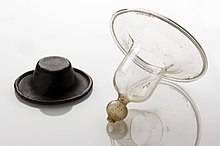
A nipple shield is a nipple-shaped sheath worn over the areola and nipple during breastfeeding. Modern nipple shields are made of soft, thin, flexible silicone and have holes at the end of the nipple section to allow the breast milk to pass through.
Nipple shields are used in various situations:
Most doctors and lactation consultants stress that nipple shields use should be temporary; the aim is always to return to regular breastfeeding, unless otherwise indicated.
Breast shells may be confused with nipple shields, but shields are intended for use during the act of breastfeeding, whereas breast shells are worn in preparation for breastfeeding.


Older nipple shields were made of latex and harder, thicker plastics, and often caused more problems than they solved. Before the invention of plastics, nipple shields were made of metal, glass, or ivory. A 17th-century nipple shield held in Shakespeare's birthplace is made of pewter.[citation needed] Nipple shields were even made of lead, which can cause lead poisoning.[1][2]